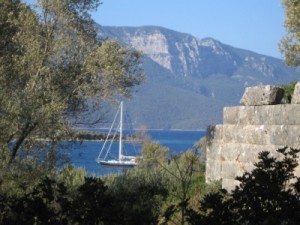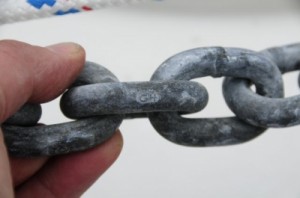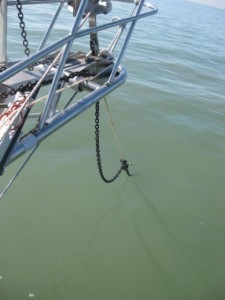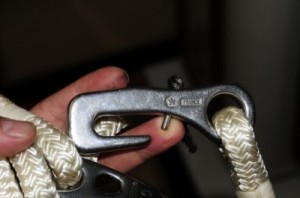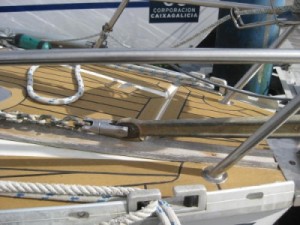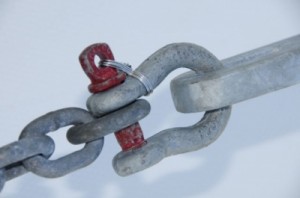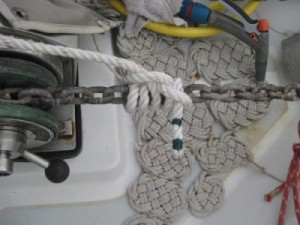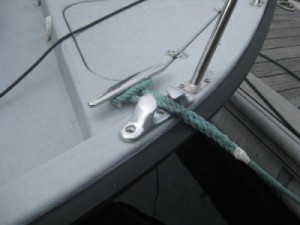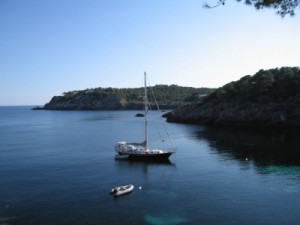Guess Where the Devil Resides?
By Dick Stevenson
Photos by Dick Stevenson and Steve D’Antonio
Dick Stevenson
Alchemy at anchor in Turkey. Feeling confident about how well your boat is anchored is paramount for enjoying yourself ashore, and for a good night’s sleep.
There are a few details that we have figured out about anchoring over the years that have worked well for Alchemy (single masted cutter, 16 ton). In the Med & Europe, where we have been the last four-plus years, we hole up for the winter and only anchor 100-150 nights a season. When we were in the US/Caribbean/Bahamas, we were able to sail year round. Our everyday anchor setup is a 66 pound Spade on 240 feet of 5/16 inch G4 Acco chain.
Steve D’Antonio
Grade 40 High-Test or G4 hot-dipped galvanized anchor chain, is ideally suited for marine windlasses. The short links make it especially flexible and the galvanization process ensures corrosion resistance.
Pennants and Snubbers:
The benefits of a long stretchy pennant are manifold. We use a 35-foot 7/16” three-strand nylon pennant. When fully deployed, it will stretch like a rubber band and transfer loads to the anchor gradually and absorb shock loads like big waves and gusts rather than transferring the loads sharply down the chain to the anchor. It also allows the anchor to ease into resetting more gradually when dealing with wind shifts, a huge benefit in a line squall with winds changing 180 degrees and gusting. I am sure this saved us from dragging in a thunderstorm in Marsh Harbor, the Abacos when we got hit by a 65-knot blast from astern and 45+ knots for 10-15 minutes. Many other boats went zooming past, anchors dragging. The only real concern about using a small diameter pennant is not strength, good nylon is plenty strong enough, but chafe. On Alchemy this has not been an issue and pennants last 3-4 years (more on chafe below).
Dick Stevenson
The 3-strand snubber line, and rolling hitch knot, can be clearly seen before the snubber has been eased. When fully deployed, the knot will be below the surface.
In practice, we drop the anchor until we feel it hit bottom, make sure we back up a few feet so we do not dump chain onto the anchor, and then quickly deploy to a 3-1 or 4-1 scope depending on the depth or anticipated holding conditions. We then tie on the pennant, let out the length of the pennant and back down. (Apologies to those whose practice is to do all of this from the helm, but some of what I recommend requires someone at the bow.) We back down vigorously after the initial set to watch for dragging and the pennant keeps this powerful load off the windlass. The pennant also allows the anchor to ease gracefully into the seabed at a nice angle of attack.
Experience tells me this is good for at least force 7 conditions (near gale, 28-33 knots) so if the unexpected happens, I can still be comfortable going for a long hike ashore. In settled conditions or a crowded anchorage, we often shorten up on the pennant so just 5-10 feet are out. Even a very short pennant at this size stretches quite a bit. While backing down there is a good opportunity to watch the droop of the chain as it comes up to meet the stretching pennant. At vigorous reverse, they should about match and the friction on the windlass should be on just enough to keep the chain from running out on its own, but not fixed.
The above is best for deeper anchorages where tidal range is a consideration. If all your anchoring is in 10 feet of water without tides, then you can consider yourself very lucky, sleep well, and modify the above accordingly. In practice, we often tie on the pennant at about the appropriate scope for the depth/conditions and then back down with the full 35 feet of pennant out. This allows the anchor to set with a very nice angle of attack to the sea bed. Then, in settled conditions and forecast and unless we are leaving the boat for a longer period, we bring in most of the pennant.
Even a very short pennant at that size stretches quite a lot. If things then get boisterous, usually at night, I just put out more pennant and chain till the whole 35 feet are out. If things are at all breezy, or the forecast is for breeze, then we just use the whole pennant from the get-go. (I suspect that we “sail” around at anchor less with the pennant out, but of this I am not sure.)
Steve D’Antonio
This stainless chain hook is well made and has a pin to keep it captive on the chain link, but it may not always be the best choice for use with a chain snubber.
Speaking of pennant attachments, I would argue for the use of a rolling hitch over a chain hook. For some, there is concern about the stainless steel riding on galvanized chain connection, but that does not seem to me very problematic in everyday life. It is more the occasional fire drill that causes the problem.
It is 3 in the morning and you awake to hear the wind rising. By the time you get to the foredeck it is blowing 30+ and the bow is already bouncing up and down and the chain/pennant are tight. You have plenty of room behind you. With a chain hook, you must bring in the chain, retrieve the hook and then let out. The last thing you want to do is shorten scope to bring in rode. It may mean loading up the windlass (many are not up to the task as described) or starting the engine. If you throw off the pennant you likely lose the hook and pennant (unless moused, which is not going to happen in everyday anchoring life). If your pennant is tied on with a rolling hitch**, you just cast off the pennant when it reaches the end, let out as much chain as you wish, tie on a dock line as pennant and you are back in bed in a few minutes, no strain on the windlass, engine or your body. Later, you can retrieve the pennant as you bring in chain.
Dick Stevenson
It is a common misconception that an anchor chain needs a swivel to keep it from twisting and jamming, or to enable the anchor to be retrieved. Many swivels have enclosed components which can suffer from wear, fatigue and failure.
I would also challenge the wisdom of another piece of metal, the swivel (and especially any swivel that “locks” onto the anchor, for a sideways pull if/when the anchor gets jammed will pry the jaws of the swivel open easily). Common sense (or at least my version) leads me to question whether the galvanized swivels do their job when under load, which is when they would be most useful. The stainless versions are very expensive, and I think both stainless and galvanized ones are an unnecessary weak point in an anchoring system. I have anchored for almost a decade of live-aboard life without swivels and have discerned no reason to have one. In the end, twist can always be taken up by the pennant making a swivel unnecessary.
Steve D’Antonio
The connection of the anchor to the chain should not be treated lightly. Use a high-quality shackle and properly seize the pin with stainless wire. Correctly installing seizing wire is an art.
Note: After long search and a little help from my friends, I found Crosby, a Canadian maker of D shackles among many other connectors/products. Their 3/8″ G-209 A shackle fits my 5/16” G4 Acco chain perfectly and is an alloy that does not make for a weak link. No other shackle I could find matched their specs. A selection of their shackles as well as twin and double clevis links will provide for creativity and safety when the next challenging anchoring situation presents itself.
Chafe: Clearly chafe is of more concern the longer you leave the boat unattended and the more extreme the conditions. We have a bridle with a chain hook (able to be moused) and 25-foot legs for storm/hurricane conditions. Chafe should not be an issue with any boat that is lived aboard.
Dick Stevenson
A rolling hitch is simple and quick. The extra turns before the hitch make it resistant to slipping and like any good knot on a boat, it can be untied even after it has been loaded.
**When done regularly, the rolling hitch takes five to ten seconds to tie and another few seconds to hand tighten. Hand tightening makes jams unlikely or you can add a loop on the near side and the far side of the knot to almost preclude jams. Once familiar with the knot, other uses on board will emerge.
Dick Stevenson
The spliced loop in the end of a dockline makes for a quick connection, but makes the line adjustable from only one end. An especially high or low tide could cause a bar-tight line problem that might only be solved with a sharp knife.
On Docklines and Cleats…
The cleat is an amazing invention. Properly sized, with a couple of quick turns, it will hold a line till the line goes first. Even under great pressure, line can be safely slipped, completely under control. Those attributes make for great flexibility in the (for me) always anxious transition from sea to land by facilitating the safety of the vessel and, more importantly, of the line handlers. I hope the following provides some food for thought.
Alchemy’s dos and don’ts for securing the boat to the dock.
1. Use your cleats. Do not have spliced loops in your docklines. If a loop is needed (like for a piling) make one with a bowline, it takes a second. A spliced loop is impossible to adjust under load. You might as well nail the rope to the deck. Spliced loops are often too large to go through chocks. Adjusting and working with spliced loops often entails working with your fingers around fixed objects such as cleats and chocks when the line is about to come under load. That scares me. A good old straight rope provides the most flexibility and safety and allows you to make appropriate use of that great invention, the cleat.
2. Coming into a dock, initially, just secure the boat. Then, at leisure, dead end the lines on shore with a little left over for adjustment while leaving the bulk of unused line on the boat. Adjustment, if boisterous conditions arise, is generally best done from the boat where the engine (and, if you are so lucky, the bow thruster) can horse the boat around and working the lines on your own familiar deck. Adjusting from shore usually requires back/body power (I am too careful of my back) and holds the danger that the bitter end may get away from you.
3. Generally, I consider looping a dockline to the dock cleat or ring and then back to the boat for securing to be justified in two situations: a settled-conditions’ overnight, or when preparing to leave the dock and you want to slip the control line at the last minute. I do this because, if chafe occurs, (most likely at the dock rather than on the boat), I want it to happen as close to the end of the line as possible. Dead ending it on the dock cleat or ring as in #2 above places chafe near the end of the rope. If the worst happens, you cut away a few feet and still have a usable line. Moreover, adjusting lines becomes more difficult and you end up with a pile of rope on the cleat making it less usable for a breast line or spring.
4. Purchase some small diameter 3-strand nylon lines and throw away those awkward, hard-to-store, expensive, surge springs and rubber shock absorbers. Set up the boat safely with your regular docklines maybe a bit looser than you might choose otherwise. Then, take your small, sacrificial 3-strand nylon lines and place them taking most of the load where you would normally put your surge springs or rubber shock absorbers. They will act like a rubber band and in the unlikely event they chafe through, you will have your regular hefty lines as back up. Go smaller than you think as they are only for the surge and not for security. I think you will be surprised how long they last.
5. My preference for dock line is a good quality three-strand nylon. New England’s top of the “line” is very good. Three-strand is the most stretchy, has great strength and abrasion resistance. Although they usually happen in just the cover, I do not like the snags that accumulate in braid. Three-strand also allows me to butt splice if there is damage, which compromises the line’s strength a bit, but can keep it still useful. New white line quickly looks a little dirty and used, but then stays looking just a little dirty and used forever.
Dick Stevenson
Dick Stevenson is a retired Clinical Psychologist/Psychoanalyst who, with his wife Ginger, has been living aboard their cutter, Alchemy, a Valiant 42, for almost 10 years. They started with 25 years of cruising the North East United States (Bermuda to Maine) with their 3 children. In 2002 they retired, sold the house, and moved aboard full time. They have wandered the NW Caribbean, Bahamas, and parts of the eastern Caribbean. Without crew, they crossed the North Atlantic in 2006 with stops in Bermuda and the Azores. Alchemy has just left the Mediterranean after 4 years where they spent the bulk of their time in the usual Med cruising grounds, while also making port and exploring all the Middle East countries, and a couple in North Africa. After years in mild climates (and against most advice from the cruising community), they are heading north to London, England for the winter. They look forward to these historic northern maritime areas and will see how long they last with the cooler wetter weather and shorter sailing season. Dick is a member of the Cruising Club of America, The Ocean Cruising Club and a Commodore of the Seven Seas Cruising Association, holds a Captain’s license, USCG, and is an Amateur Radio operator, call sign KC2HKW.
Sailing notes and Alchemy’s whale story
We left Gijon, Spain, mid-morning after filling with fuel. We were sailing before we left the channel in a 15-knot WNW breeze and we were going NE. Perfect. It was a good start to our crossing catty-corner the infamous Bay of Biscay. Expecting the wind to increase as we moved away from land, we put a reef in the main and started trucking toward France 250 miles away. The only remarkable item in the first few hours was how impressive the swells were from the west, 10-12 feet. This made for a lot of boat movement, herky jerky at times, but luckily the wind stayed just potent enough to keep Alchemy fairly predictable and comfortable, but not enough to create more big waves. Later in the day, movement eased as the swells spread out when we moved into deeper water.
The wind was predicted to veer and lighten, which it did. Impressively, it veered and lightened to a degree that kept us moving comfortably and fast as we added more sail area. We needed to make adjustments now and then, but these were essentially fine tuning and the wind never forced us to change course. 053 degrees magnetic for 41 straight hours.
The first night out we saw almost no traffic; always a blessing. And the second day we just kept sailing along, positive that conditions would change, that we would have to tack, and our arrival estimate of the following morning would be accurate. The second night we saw lots of traffic, some very confusing, including a moving orange-ish strobe light which kept being right in front of Alchemy’s course. It was particularly disconcerting as, unlike other light sources, with a strobe light it is very hard to have any depth perception. So, one minute it looked close and the next it was way off. This went on for 1-2 hours. Later research revealed it was a trawler wandering around fishing and that in this part of the world they have moved from the traditional green over white light pattern to this strobe to communicate their action.
It also became clear that sailing conditions would hold, we would have a fast passage, and thus we would be arriving in the dark. Traffic action stayed busy as we closed the land about 1:00 in the morning and sailed down the side of an island to an anchorage where we could safely sleep and wait for light to go into La Rochelle, France. About a half hour before the anchorage, we heard this high keening sound and lots of splashing around the boat. We were sure that a dolphin group had found us until, in the bright moonlight, the pod moved closer and we discovered we had 10-12 pilot whales cavorting close to our stern, more on the bow. They were unmistakable, magnificent, and though 20 feet long, ever so graceful, as “singing” constantly, they kept up with Alchemy (6-7 knots) for 15-20 minutes or so, giving us the most wonderful welcome we have ever had to a harbor.
We anchored close to the La Rochelle entrance channel about 3:30 in the morning averaging just under 6.1 knots for 41 hours sailing door to door. For sail passages, it does not get much better. And that goes at least double for Bay of Biscay passages.
For more information on the services provided by Steve D’Antonio Marine Consulting, Inc. please e mail Steve atinfo@stevedmarineconsulting.com
or call 804-776-0981


